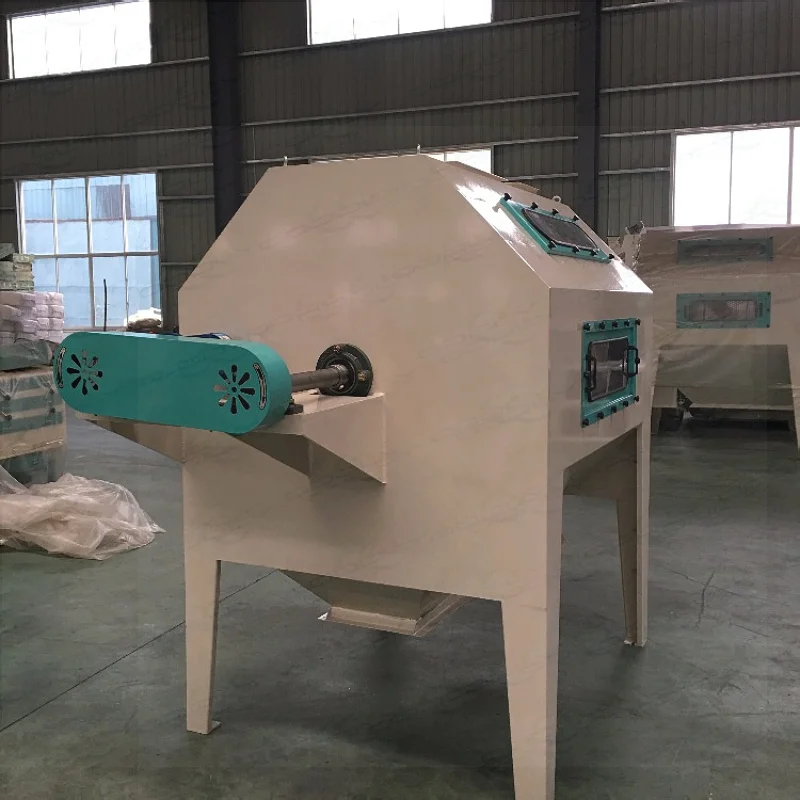In contemporary rice-milling operations, the rice pre cleaner machine has become an indispensable front-end unit for stabilizing production, protecting downstream equipment, and ensuring raw material purity. Its primary role is to remove large, mixed, or hazardous impurities before paddy enters fine cleaning and dehusking processes. As global rice processing shifts toward automated, high-capacity, and safety-driven practices, the design logic and technical configuration of pre-cleaning systems have become critical indicators of mill performance.
A professional pre-cleaner is not simply a vibrating sieve—it is a coordinated mechanism engineered to manage material flow, protect processing surfaces, maintain structural reliability, and uphold safety standards throughout long-term industrial operation. In this blog post, ODDLY, as high performance grain pre cleaner exporter, will share the advantages of industrial rice pre cleaner machine for high purity grain processing.
How Industrial Rice Pre Cleaner Machine Improves Grain Purity and Throughput
Industrial rice pre cleaning equipment directly affects yield stability and product quality. By separating straw, stones, chaff, dust, and metallic impurities at an early stage, mills experience fewer blockages, reduced machine wear, and a cleaner input stream for subsequent machinery such as destoners, huskers, and whiteners.
More importantly, high-quality pre-cleaning ensures that raw material purity aligns with national and international milling standards, resulting in:
-
More consistent finished-grain appearance
-
Higher head-rice recovery
-
Lower contamination rate
-
Increased operational continuity
In modern processing lines, failing to optimize the pre-cleaning stage means risking downtime, defective batches, and potential safety issues.
Technical Highlights: Professionalism Hidden in Every Detail
The performance of an industrial rice pre cleaner machine lies in seemingly minor engineering decisions. Each structural detail contributes to durability, throughput, and product stability.
Buffer Feed Hopper: Controlled Loading and Longer Service Life
The buffer feed hopper moderates the impact force of incoming paddy, ensuring that the grains are evenly fed without producing sudden loads. This controlled delivery provides three essential benefits:
-
Reduced material impact on the screen mesh
-
Lower vibration stress across the sieve layers
-
Service life extended by more than 2×
By preventing pressure shock, the hopper maintains sieve integrity and enables long-term precision screening.
V-Shaped Impurity Collection Tank for Automatic Discharge
Large impurities—corn cobs, branches, stones, and bulk foreign objects—are directed into a V-shaped collection tank that guides them outward through a natural sliding action. This geometry eliminates residue accumulation and prevents cross-contamination between successive batches.
No manual intervention is required, and no additional cleaning cycles interrupt the workflow.
Industrial-Grade Transmission System for Heavy-Duty Use
A robust transmission system defines the machine’s operational reliability. The use of industrial-grade bearings, a protective motor, and an IP54-rated enclosure ensures stable and consistent running even in humid, dusty, or vibration-intensive environments.
This configuration reduces lubrication frequency, maintains balanced torque output, and supports continuous operation across long shifts.

Operational Value: What You Get Is More Than Just Equipment
A professional pre-cleaner does more than remove impurities—it safeguards the entire production line.
Improved Efficiency: Higher Capacity Utilization
By preventing blockages caused by straw bundles, husk clusters, and bulk impurities, the machine significantly reduces cleaning downtime. Mills typically see:
-
15%+ increase in capacity utilization
-
Stable feed rate to downstream machines
-
Smooth workflow without unplanned stops
This makes the pre-cleaner a key contributor to overall plant productivity.
Quality Assurance: Meeting Raw Grain Cleanliness Standards
With effective separation of oversize and hazardous impurities, the cleanliness of pre-processed rice consistently meets or exceeds industrial standards. The outcome is:
-
100% qualified finished-product batches
-
Reduced risk of defects originating from upstream contamination
-
Improved consistency in later polishing, grading, and sorting
This ensures that each stage of the rice-processing line receives uniformly clean input.
Safety Benefits: Eliminating Collision Sparks and Explosion Risks
Iron fragments, bolts, and metallic impurities pose a hidden danger—collision sparks can ignite dust-laden environments. The pre-cleaner eliminates this risk by removing metallic objects before they enter high-speed machinery.
Therefore, the machine becomes a vital safety apparatus for preventing:
-
Dust explosions
-
Machine damage caused by impact
-
Fire hazards inside enclosed facilities
Functional Structure: How Industrial Rice Pre Cleaning Machines Work
A complete pre-cleaning system integrates controlled feeding, layered screening, and effective impurity discharge. Its design ensures high throughput while maintaining precision separation.
Extended Sieve Structure for High-Efficiency Cleaning
An extended sieve increases screening area and contact time. This enables the machine to process larger volumes of paddy while maintaining separation accuracy, particularly for oversized impurities.
The result is a higher efficiency level without resorting to excessive vibration intensity.
Dual-End Support for Stable Vibration and Reduced Stress
By supporting the sieve body on both ends, the machine achieves:
-
Balanced vibration distribution
-
Reduced structural deformation
-
Longer equipment lifespan
This mechanical balance directly contributes to consistent separation and minimizes the chance of uneven wear.
Adjustable Airflow (Optional in Advanced Models)
Some models integrate airflow guides to enhance removal of light impurities such as chaff or dust. Although optional, this feature is valuable for large-scale mills requiring maximum cleanliness before aspiration.
Role of Rice Pre Cleaner in Full-Scale Milling Lines
When properly configured, the pre-cleaner becomes the foundation of an efficient rice-processing line. It protects critical downstream equipment—such as destoners and huskers—by ensuring clean, uniform feeding.
In high-capacity plants, even small percentages of impurity load translate into significant wear and energy waste. Thus, the pre-cleaner acts as a cost-saving filter that maintains equipment performance across thousands of production hours.
Selecting the Right Industrial Rice Pre Cleaner Machine for Your Facility
Choosing a suitable pre-cleaner involves evaluating milling capacity, impurity load, and environmental conditions.
Key Purchasing Considerations
-
Screen length and sieve mesh variety – to match different raw material profiles.
-
Transmission durability – especially for plants operating 20+ hours per day.
-
Discharge method – automatic discharge improves workflow stability.
-
Environmental protection – IP54 motors for dusty or humid areas.
-
Maintenance accessibility – easy screen replacement and minimal downtime.
A well-selected machine provides stable quality and reduces long-term operational costs.
Long-Term Economic Benefits of a Professional Pre-Cleaning System
While pre-cleaners represent a small fraction of total equipment investment, they generate substantial savings through:
-
Reduced breakdown frequency
-
Lower spare-parts consumption
-
More consistent throughput
-
Improved product recovery rates
By preserving the integrity of downstream machinery, the equipment pays for itself through lowered maintenance and improved yield.
Why Modern Rice Mills Prioritize Advanced Pre Cleaning Technology
As consumer expectations grow and global rice markets demand hygienic, uniform, and safe products, rice mills must adopt technology that supports traceability, safety, and quality.
The industrial rice pre cleaner machine bridges the gap between raw harvesting and precision milling—transforming bulk paddy into a clean, controlled input suitable for high-value processing.
It is not simply an accessory; it is the first guarantee of production stability, quality assurance, and operational safety.
www.oddlyricemill.com
ODDLY

